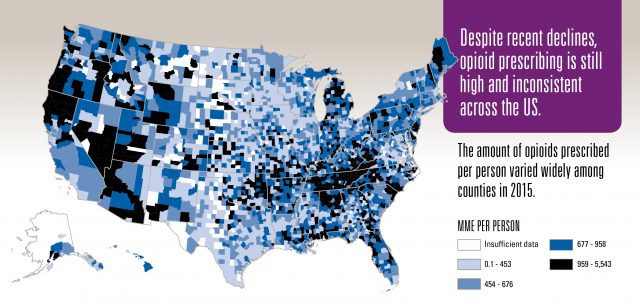
Brought to you by WBIW News and Network Indiana
Last updated on Tuesday, July 11, 2017
(UNDATED) - Lengthy prescription regimens and high doses of opioid painkillers continue to subject Americans to high risk of drug addiction, despite efforts taken to tackle the country’s opioid crisis, Centers for Disease Control and Prevention (CDC) officials said this week.
"Half of U.S. counties saw a decrease in the amount of opioids prescribed per person from 2010 to 2015. Overall opioid prescribing is down 18 percent since 2010," CDC Acting Director Dr. Anne Schuchat said.

Amy De Silva, of Talk Media News reports, despite an overall decline in prescriptions, Americans are still being prescribed increased doses of opioids for longer durations of time. Opioid prescriptions lasting more than three months, even in low doses, "increases the risk of addiction by fifteen times," Schuchat said.
"The average day supply per prescription increased 33 percent from 13 days to 18 days from 2006 to 2015," she added.
While numerous factors contribute to the opioid crisis, a recent CDC survey of state-by-state opioid prescription patterns found three states - Florida, Kentucky and Ohio - that led the pack in lowering the overall prescriptions.
Laws in all three states require physicians to consult online Prescription Drug Monitoring Programs (PDMP) when prescribing opioid painkillers. Those databases provide doctors and pharmacists with information about whether a patient is likely to be abusing prescription medications or diverting drugs for illegal sale. Based on information obtained from PDMPs, doctors can recommend physical or behavioral therapy to patients as safer alternatives to opioid prescriptions.
"As PDMPs are integrated into medical records we will continue to see a transformation in the culture around control substance prescribing," said Dr. Caleb Alexander, co-director of the Johns Hopkins Center for Drug Safety and Effectiveness.
Alexander said PDMPs are "powerful tools" that quickly alert doctors to "patients that are at an elevated risk, regardless of the number of physicians that patients are seeing to get their prescriptions filled."
Every U.S. state with the exception of Missouri currently operates a PDMP in some form. But funding for those programs varies widely, leading to what CDC officials said are extreme differences in prescription patterns state-to-state and county-to-county.
Opioid prescribing varies as much as place to place as the weather, and even neighboring counties can have a major difference in prescribing levels," Schuchat said.
According to the CDC, the counties in the U.S. with the highest number of prescriptions dispensed six times more opioids per resident than lower prescribing counties.
States and counties also differ in the degree to which PDMPs fit into a broader set of opioid addiction policies.
"First and foremost, folks need healthcare, and they need diverse facilities that host a broad range of services harm reduction services.," Grant Victor, president of the University of Kentucky chapter of Students for Sensible Drug Policy, said. "This includes, drug treatment, syringe access, replacement therapy."
CDC leaders agree.
"Everyone has a role to play to help address this issue and become a part of the solution,"
Schuchat said.
1340 AM WBIW welcomes comments and suggestions by calling 812.277.1340 during normal business hours or by email at comments@wbiw.com
© Ad-Venture Media, Inc. All Rights Reserved.